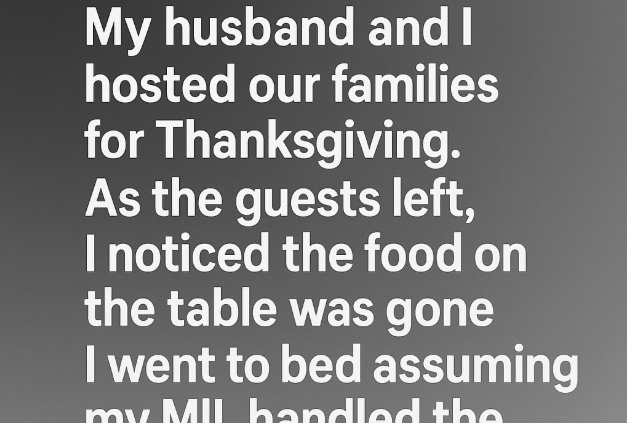My husband and I devoted several days to getting everything ready for welcoming both branches of our family to celebrate Thanksgiving together. The evening unfolded with vibrant energy, filled with heartfelt discussions and an array of delicious home-cooked meals. As the final visitors departed, I observed that the dining area appeared entirely tidied up. I figured my mother-in-law had generously handled the post-meal organization, which brought me a sense of ease. I headed off to sleep with the conviction that all matters were properly resolved.
The following morning, I stepped into the kitchen eager to savor some of the remaining portions from the feast. Upon swinging open the refrigerator door, I discovered that every storage vessel stood vacant and arranged in precise order. No trace remained of any edible item from the previous night’s spread. Perplexed, I pondered the rapid vanishing of all those provisions. My husband and I racked our brains trying to unravel the mystery surrounding the occurrence.
A bit later, we reached out to my mother-in-law simply to touch base and see how she was doing. She cheerfully described how she had carefully portioned out the entire selection of food into packages for distribution among the departing attendees. Every household assumed those packaged remnants were intended specifically for their enjoyment, prompting them to carry them away with sincere appreciation. Her goal centered on preventing any waste rather than depriving us of anything. Listening to her account allowed us to grasp the full picture without any lingering doubts.
Ultimately, this experience served as a valuable illustration of the essential role that open dialogue plays in family dynamics. An initial wave of letdown evolved into an insightful revelation about the varied expressions of affection that people demonstrate. We decided to release any traces of annoyance and instead embraced the kindness embedded in her actions. For the upcoming Thanksgiving celebration, we took proactive steps by preparing in advance and attaching clear labels to the various containers of remnants designated for different groups. This straightforward adjustment fostered greater unity and mutual comprehension during our shared holiday occasions.
Reflecting on that memorable Thanksgiving, my husband and I often recall the meticulous efforts we invested in the preparations. We shopped for fresh ingredients at local markets, chopped vegetables with care, and baked pies that filled the house with inviting aromas. The gathering itself buzzed with laughter as relatives shared stories from years past, passing plates of turkey, stuffing, cranberry sauce, and mashed potatoes around the extended table. Children darted between legs, adding to the joyful chaos, while elders offered wisdom laced with humor. The warmth of the fireplace complemented the glow from string lights we had hung earlier in the week.
When the evening wound down and goodbyes were exchanged at the door, the sense of fulfillment lingered. I remember waving from the porch, watching taillights fade into the night, before turning back to survey the space. The tablecloth lay smooth, chairs pushed in neatly, and dishes absent from sight. My mother-in-law, known for her helpful nature, had always been the one to lend a hand in such situations during previous visits. Her thoughtful gestures, like folding laundry or watering plants unasked, made her a cherished presence in our home.
Waking up to an empty fridge the next day sparked a mix of curiosity and mild bewilderment. We opened cabinets and checked the pantry, half-expecting to find hidden stashes, but everything confirmed the complete absence of the feast’s survivors. Conversations with my husband revolved around possible explanations—perhaps a late-night snack raid by unexpected visitors or an oversight in storage. We brewed coffee and sat at the counter, piecing together timelines from the night before.
The phone call to my mother-in-law unfolded naturally, starting with casual updates about the drive home and weather conditions. Her voice carried enthusiasm as she detailed the packing process: sorting portions into reusable containers, tying bags securely, and handing them out with smiles. Guests expressed delight, mentioning how the treats would extend the holiday spirit into their own homes. She emphasized her upbringing in a household where food preservation ranked high, influenced by stories of scarcity from her parents’ generation.
This clarification shifted our perspective entirely. We recognized her initiative as an extension of generosity, aimed at inclusivity rather than exclusion. The incident highlighted how assumptions can lead to misunderstandings, especially across generational lines where customs differ subtly. My husband and I discussed it over breakfast, agreeing that her heart was in the right place, even if the outcome left our shelves bare.
Moving forward, we incorporated the lesson into future plans. We created a system with color-coded labels—blue for our immediate household, green for in-laws, red for my side of the family—and placed a sign on the fridge explaining the divisions. This not only prevented confusion but also sparked conversations about preferences and dietary needs. Family members appreciated the organization, and it became a talking point that strengthened bonds.
Thanksgiving traditions evolve with each passing year, and this particular story has become a lighthearted anecdote we share. It reminds everyone at the table to voice intentions clearly and listen actively. The holiday continues to symbolize gratitude, and experiences like these enrich its meaning. We now prepare extra batches of favorites, ensuring abundance for all, and the gatherings feel even more connected as a result.
In the broader scope of family life, moments of miscommunication offer opportunities for growth. My mother-in-law’s actions stemmed from a place of abundance mentality, wanting to spread joy beyond our walls. We honor that by continuing to host with open arms, adapting practices to suit everyone’s comfort. The labeled leftovers have since become a signature touch, often praised for their practicality.
Years later, the empty fridge tale elicits chuckles around the dinner table. It underscores the beauty in diverse approaches to care—some through words, others through deeds. Our family thrives on these shared narratives, building a tapestry of memories that withstand time. Thanksgiving remains a cornerstone event, brimming with flavors, faces, and newfound wisdom from that one surprising morning.





